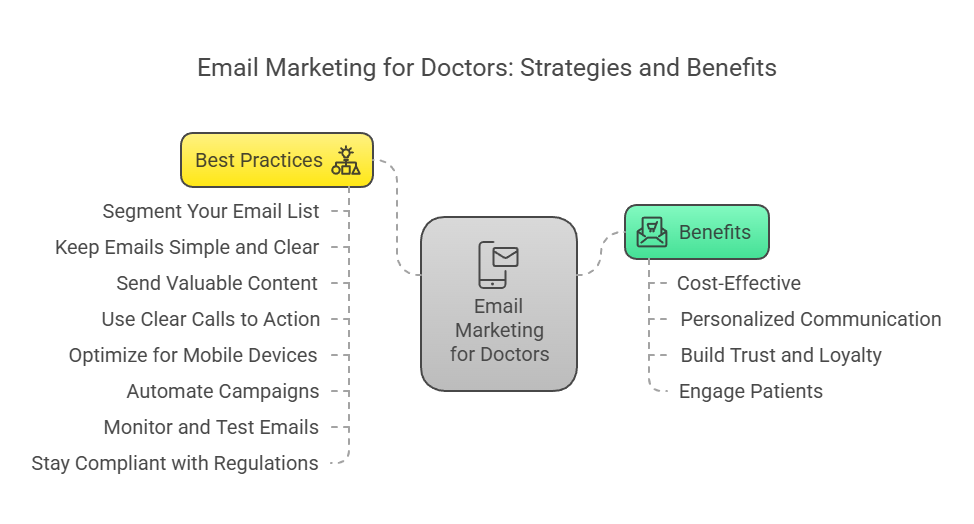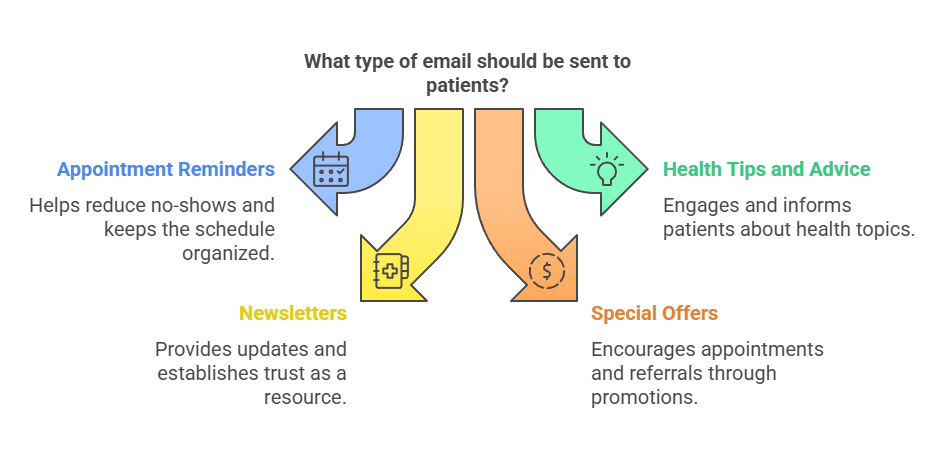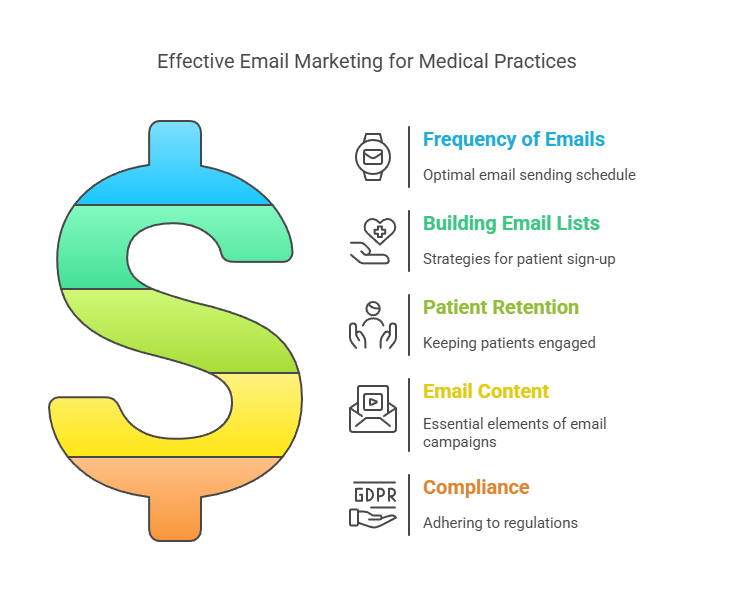Email marketing for doctors is an essential tool for staying connected with patients and growing your practice. It’s an easy, cost-effective way to build relationships, provide valuable information, and keep your practice top of mind. In today’s digital world, email marketing is a must-have strategy for healthcare professionals. This guide will walk you through why email marketing for doctors is so important and how you can use it effectively.
Why Email Marketing for Doctors is Essential
In the world of healthcare, staying in touch with your patients is crucial. Email marketing for doctors is an effective way to do just that. It allows you to maintain consistent communication with your patients, keep them informed about important updates, and promote your services. Additionally, email marketing offers several advantages for healthcare providers.
-
Cost-Effective: Email marketing is an affordable tool with a high return on investment (ROI). It’s a practical choice for doctors who want to reach many patients at once.
-
Personalized Communication: You can personalize emails for each patient based on their specific health needs, making your messages more relevant.
-
Build Trust and Loyalty: Regular email communication builds trust between you and your patients. It also keeps your practice at the forefront of their minds.
-
Engage Patients: Through targeted emails, you can keep your patients engaged with health tips, appointment reminders, and other valuable content.
Email marketing for doctors is an effective strategy for both patient retention and attracting new patients. It’s a communication tool that builds long-term relationships while providing tangible benefits for both doctors and patients.
Best Practices for Email Marketing for Doctors
Effective email marketing for doctors requires strategy, patience, and consistent effort. Here are some best practices that can help you maximize the impact of your email campaigns.
1. Segment Your Email List
Segmentation is one of the most powerful strategies in email marketing for doctors. By dividing your email list into smaller groups based on patient needs, preferences, and behaviors, you can send targeted, relevant content. For example:
-
Send appointment reminders to patients who have upcoming visits.
-
Share specific health tips based on a patient’s condition (e.g., diabetes management, heart health).
-
Notify older patients about senior health screenings or vaccinations.
Personalized, segmented emails are more likely to be opened and acted upon. They ensure that patients receive the right message at the right time.
2. Keep Your Emails Simple and Clear
When sending emails to patients, it’s important to keep the content simple and easy to understand. Medical terms and jargon can be confusing, so use plain language in your emails. This makes the message clearer for patients who might not have a full understanding of medical terms.
Aim for short, concise emails with a clear message. A good rule of thumb is to keep your sentences under 12 words, ensuring the message is to the point. For example:
Subject: Appointment Reminder – March 30, 2025
Body:
Hello [Patient Name],
This is a reminder for your appointment with Dr. [Name] on March 30 at 10:00 AM.
Please confirm your appointment by replying to this email.
Thank you!
Short and simple emails are more likely to be read and acted upon.
3. Send Valuable, Relevant Content
Email marketing for doctors should offer value to your patients. Whether it’s health tips, updates on new services, or reminders about check-ups, the content should be useful and relevant to your audience. For example, if you are a family doctor, you could send a monthly newsletter with tips on staying healthy for all ages. You can also include information about flu season, vaccination schedules, or seasonal health advice.
Relevant content helps establish your authority and keeps your patients engaged with your practice.
4. Use Clear Calls to Action (CTAs)
Every email should have a clear call to action. A call to action is a prompt that tells the reader what action to take next. Whether it’s booking an appointment, signing up for a newsletter, or learning more about a specific treatment, make sure the CTA is clear and easy to follow.
For example, a CTA in an appointment reminder email might look like:
“Click here to confirm your appointment.”
This helps drive action and ensures that your emails are effective.
5. Optimize Your Emails for Mobile Devices
More people are checking their emails on smartphones and tablets. Therefore, your emails must be optimized for mobile devices. A mobile-friendly email is easy to read, with legible text and properly sized images. Buttons and links should also be clickable on smaller screens.
If your emails aren’t optimized for mobile, you risk losing patient engagement. A simple test can help you ensure that your emails look great on any device.
6. Automate Your Email Campaigns
Email marketing automation can save you time and ensure that important emails are sent on time. Automated emails can include appointment reminders, post-visit follow-ups, or health tips. For example, you can set up an automated campaign to remind patients about annual check-ups or vaccination schedules.
Automation helps you stay in touch with patients without having to send each email manually, improving efficiency and reducing the risk of missing important communications.
7. Monitor and Test Your Emails
It’s important to continuously monitor and test your email campaigns. A/B testing can help you determine which subject lines, CTAs, and content types resonate best with your audience. Test different strategies to see what works best for your patients.
For example, you might test sending emails at different times of the day or experimenting with different subject lines to see which one gets a higher open rate.
8. Stay Compliant with Regulations
Doctors must comply with strict privacy regulations when communicating with patients. In the U.S., this includes the Health Insurance Portability and Accountability Act (HIPAA). Always ensure that patient information is kept secure and that you are not violating any privacy laws.
Before starting your email marketing campaigns, check that your email platform complies with HIPAA. It’s also important to gain consent from patients before sending them marketing emails.
Types of Emails Doctors Can Send to Patients
There are several types of emails that doctors can send to patients. Here are a few examples of how you can use email marketing for doctors:
Appointment Reminders
Sending appointment reminders is one of the most common types of emails in the healthcare industry. These reminders help reduce no-shows and keep your schedule organized. You can send reminders a day or two before the appointment and include an easy way for patients to confirm or reschedule.
Health Tips and Advice
Sending helpful health tips via email keeps patients engaged and informed. You could provide advice on nutrition, exercise, mental health, or managing specific medical conditions. For example, you could send a monthly email with tips for managing chronic pain or preventing the flu.
Newsletters
Regular newsletters help keep your patients informed about new services, treatments, or updates in your practice. You can also include educational content, such as blog posts or videos, about common health concerns. A newsletter provides a great opportunity to establish your practice as a trusted resource for medical information.
Special Offers or Promotions
If you offer any discounts, seasonal promotions, or new patient specials, email marketing is an effective way to share this information. A clear email with details about your promotion can encourage patients to schedule an appointment or refer others to your practice.
Follow-Up Emails
After a visit or medical procedure, it’s helpful to send follow-up emails to check in with your patients. This can be a great way to show you care about their well-being and encourage them to take the next step in their care.
Key Statistics for Email Marketing for Doctors
Email marketing for doctors is highly effective, with statistics supporting its role in patient engagement. According to a study by Digital Health Agency, healthcare email campaigns have an open rate of 21.5%, which is above the industry average. This shows that patients are engaging with healthcare providers through email.
In another survey, 77% of patients indicated that they prefer receiving healthcare information through email. This demonstrates how powerful email marketing can be for doctors in reaching their audience and fostering better communication.
FAQs About Email Marketing for Doctors
1. How often should doctors send marketing emails?
Doctors should aim to send marketing emails once a week or once a month. This helps maintain engagement without overwhelming patients.
2. How do I build an email list for my practice?
Ask patients to sign up for newsletters during their visits. You can also offer incentives for signing up, such as free health resources or discounts.
3. Can email marketing help with patient retention?
Yes, email marketing helps keep patients engaged with your practice. By sending valuable content and reminders, you build trust and encourage patients to return for future visits.
4. What should be included in a doctor’s email campaign?
A doctor’s email campaign should include appointment reminders, health tips, updates on services, and educational content. Make sure the content is relevant to your patients’ needs.
5. How do I ensure my email marketing is compliant with regulations?
To ensure compliance, use an email marketing platform that meets HIPAA requirements. Always secure patient data and obtain consent before sending marketing emails.
Final Thoughts on Email Marketing for Doctors
Email marketing for doctors is a powerful tool that helps maintain communication with patients, drive appointments, and promote services. By following best practices such as segmentation, personalization, and compliance with regulations, you can create an effective email marketing strategy that benefits both your practice and your patients. Keep testing and optimizing your campaigns to achieve the best results. With the right strategy, email marketing can significantly contribute to the success of your medical practice.




